Blogging Marvel’s The Tomb of Dracula, Part Five
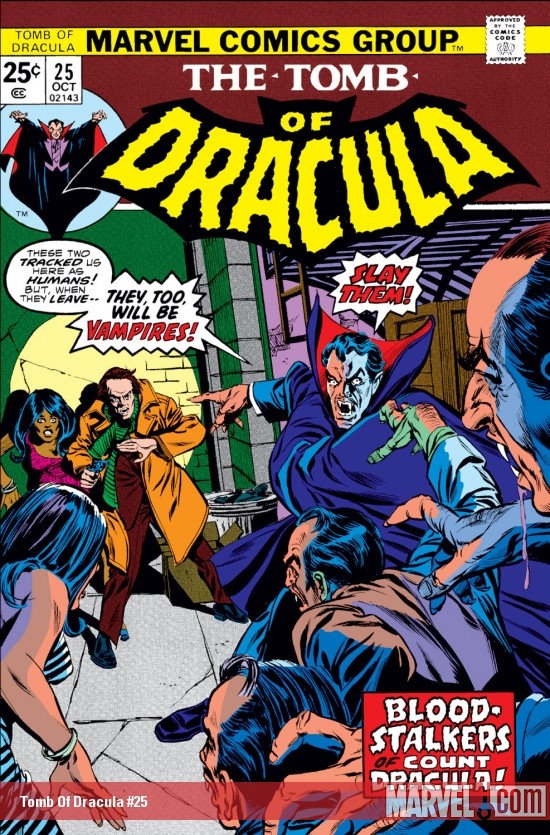
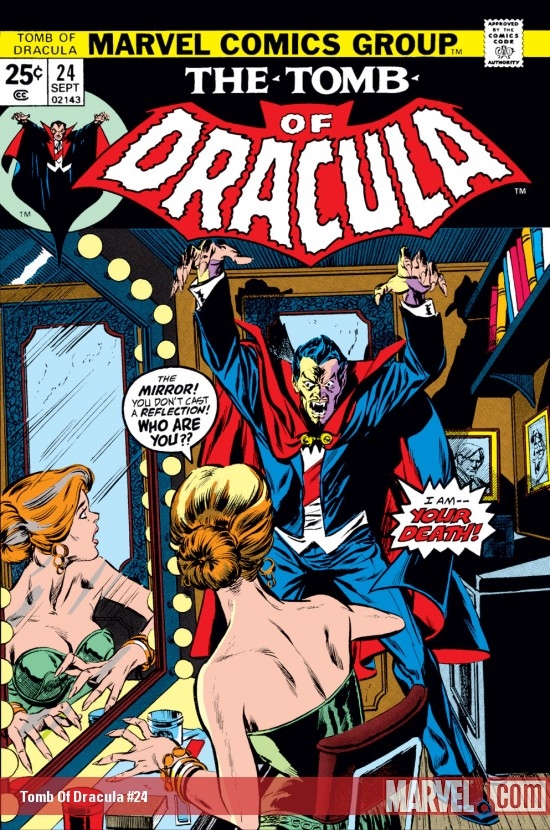 The Tomb of Dracula # 24, “A Night for the Living, a Morning for the Dead” sees the series make a quantum leap forward in terms of the sophistication of Marv Wolfman’s script. The story begins with Frank Drake and Rachel Van Helsing on the same bridge Frank nearly jumped off when he was rescued by Taj Nital two years before. Believing Dracula dead, Frank has come to both a physical and symbolic bridge in his life and feels lost. The promise of a blossoming romance with the equally damaged, but far more capable Rachel Van Helsing is the only thing that pulls him from the depths of despair. Of course, Dracula is alive and preying on innocent women on the streets of London at night while his mortal lover, Sheila Whittier sits at home alone awaiting his return and doing her best to deny the reality that the man she loves is a ruthless killer.
The Tomb of Dracula # 24, “A Night for the Living, a Morning for the Dead” sees the series make a quantum leap forward in terms of the sophistication of Marv Wolfman’s script. The story begins with Frank Drake and Rachel Van Helsing on the same bridge Frank nearly jumped off when he was rescued by Taj Nital two years before. Believing Dracula dead, Frank has come to both a physical and symbolic bridge in his life and feels lost. The promise of a blossoming romance with the equally damaged, but far more capable Rachel Van Helsing is the only thing that pulls him from the depths of despair. Of course, Dracula is alive and preying on innocent women on the streets of London at night while his mortal lover, Sheila Whittier sits at home alone awaiting his return and doing her best to deny the reality that the man she loves is a ruthless killer.
The complexities of Wolfman’s script only grow as the story shifts to Blade who returns to his and Safron’s apartment to find her being menaced by a vampire. While Blade quickly dispatches the vampire in particularly bloody fashion for a 1974 mainstream comic, the bigger shock is the more adult turn the book takes in content. After fading out on Blade and Safron kissing, the scene picks up later that night and we see Blade dressed only in pajama bottoms with Safron dressed only in his matching pajama tops. If this wasn’t going far enough, they are interrupted by the unexpected arrival of Trudy, a fellow exotic dancer who works at the same club as Safron. She tells of her near-miss encounter with Dracula which Gene Colan illustrates via flashback. The sequence alternates between sexy and terrifying as Dracula is portrayed at his most predatory yet by having him attack a character who readers find both desirable and sympathetic. The fact that Trudy is saved from her attack by wielding a cross is nothing for Wolfman has Dracula continue to pursue her as she runs through the streets of London clad only in bra and panties and an open overcoat while Dracula savagely taunts her until she wields the cross a second time and finally drives him off. Wolfman and Colan clearly enjoyed making the series more adult in terms of story structure and certainly content.
Blade subsequently sets out to hunt for the vampire lord he believed dead and his rematch with Dracula on the streets of London is quickly underway. Their skirmish is intercut with Taj Nital’s anguished reunion with his estranged wife in India. This time we learn the conflict between them involves their son who Taj learns is dying. The battle between Dracula and Blade concludes uneventfully, but Blade is injured both physically and psychologically by how easily Dracula defeated him. This remarkable issue concludes with Dracula returning home exhausted and paying scant attention to Sheila while Frank makes a tearful break with Rachel determined that he must find himself before he can commit to a relationship with her. The entire issue is a marvelous example of strong characterization and demonstrates how to best achieve dramatic scope in a story. Nearly four decades later, comic standards have loosened considerably, but the quality of writing does not compare with the level achieved by this title in its prime.
Issue #25, “Night of the Blood-Stalker” is an interesting issue that owes much to the classic (then contemporaneous) television series, The Night Stalker. The narrator/protagonist is grizzled private eye, Hannibal King. An immediately likable character in the classic hardboiled mold, King is hired in the opening panels by a newlywed bride whose husband was just murdered by Dracula. Once again, the sheer terror and savagery of Colan’s artwork in depicting Dracula’s attack on her husband via flashback serves to undermine the more sympathetic side of the character the scripts had recently portrayed. This duality was central to the book and unique for the format. Observant readers would recognize the vampire in Hannibal King’s flashback as the same white-haired vampire seen in Blade’s origin flashback a few issues before. The vampire remains nameless, but we now have two characters seeking him. King solves the case and survives his tussle with Dracula. The sting ending is King’s closing monologue in the last panel of the issue after his client departs his cramped office and the detective is revealed as a reluctant vampire himself breaking the fourth wall and looking at the “camera” to address the reader directly. It is a nice touch that Wolfman and Colan stylishly execute.
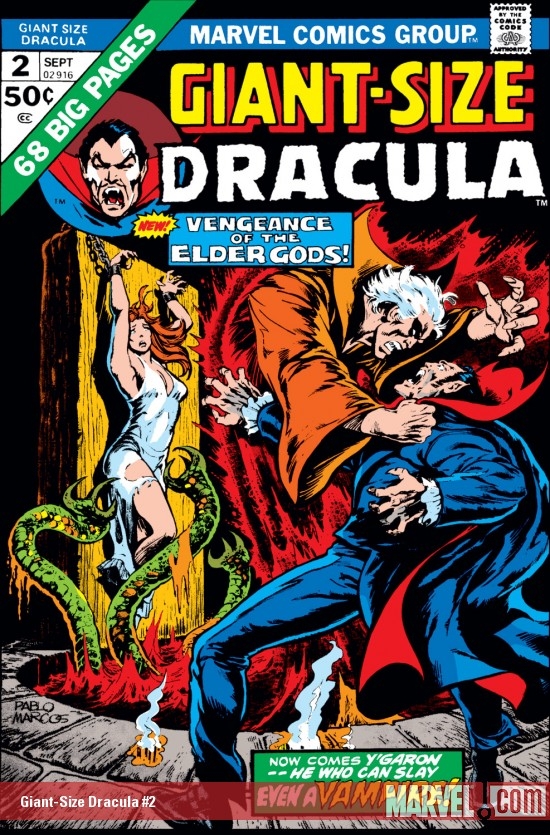
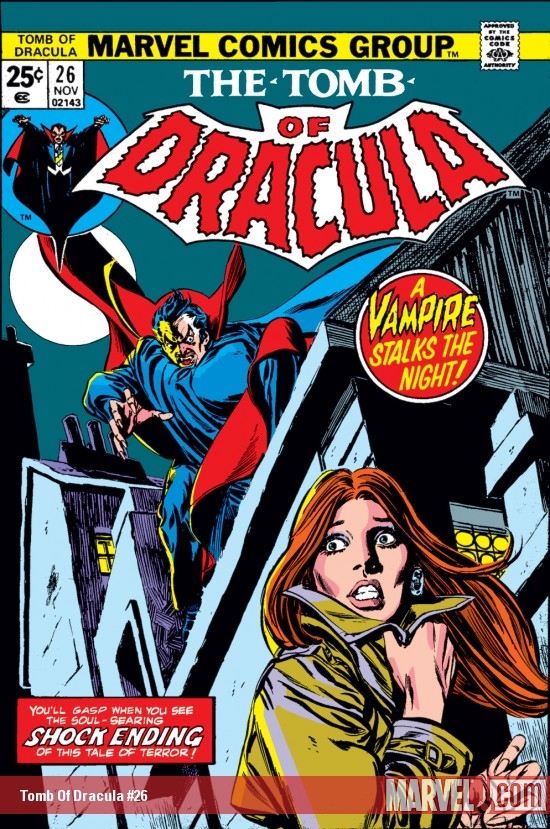 Giant-Size Dracula #2, “Call Them Triad, Call Them Death” is the first official entry in the quarterly companion series spun-off from Giant-Size Chillers. Author Chris Claremont and artist Don Heck were the creative team for the book which put the focus on a beautiful psychic investigator Kate Fraser paired with Inspector Chelm of Scotland Yard as they investigate a Lovecraftian cult worshipping the demonic Elder Gods who cross paths with Dracula. The vampire starts the story out predatory, but quickly switches to the role of the unlikely hero. Kate Fraser is an excellent character and it is nice to see Chelm used to better advantage, but Don Heck’s artwork (very much in the style of latter-day Steve Ditko) seems disappointingly routine compared with Colan’s distinctive portrayal of the characters and lets down Chris Claremont’s script which otherwise makes good use of the expanded page count to provide a film-worthy script.
Giant-Size Dracula #2, “Call Them Triad, Call Them Death” is the first official entry in the quarterly companion series spun-off from Giant-Size Chillers. Author Chris Claremont and artist Don Heck were the creative team for the book which put the focus on a beautiful psychic investigator Kate Fraser paired with Inspector Chelm of Scotland Yard as they investigate a Lovecraftian cult worshipping the demonic Elder Gods who cross paths with Dracula. The vampire starts the story out predatory, but quickly switches to the role of the unlikely hero. Kate Fraser is an excellent character and it is nice to see Chelm used to better advantage, but Don Heck’s artwork (very much in the style of latter-day Steve Ditko) seems disappointingly routine compared with Colan’s distinctive portrayal of the characters and lets down Chris Claremont’s script which otherwise makes good use of the expanded page count to provide a film-worthy script.
Issue #26, “Where Lurks the Chimera” is another brilliant issue from the respective pens of Wolfman and Colan. The story sets off on a fine note with a Biblical passage as we meet young David Eschcol and his father Joshua who run a pawnshop. After many years, Joshua Eschcol has acquired all of the pieces for a statuette of the mythological Chimera. No sooner have they assembled it then thugs break into the pawn shop to steal the statuette. David recovers consciousness to find his father dead, but learns the tail of the statuette broke off in his father’s hand leaving David as the bearer of the final piece.
A brief interlude in India sees Taj Nital convinced by his friend Ramon to reconcile with his wife before their son dies. These scenes with the mute Indian are always short, but very powerful and keep the reader intrigued to learn more. A second interlude features Dracula running afoul first of an angry mob in a London alleyway and then of the police. Dracula is also seeking the Chimera, but learns that others have beaten him to the prize except for the tail-piece which David still possesses. The next day David literally bumps into Sheila Whittier who has been dispatched by Dracula to compromise David. The identity of the other party seeking the Chimera is unknown.
The story then turns to a disheveled Frank Drake who meets a mysterious, but sexy bohemian named (ironically) Chastity Jones, who is involved with Frank’s old friend Danny Summer (briefly scene in the series’ first issue when Frank failed to get a loan from him). Danny wants Frank to join him in Brazil and has dispatched Chastity to convince him. The scene cuts away with Frank fresh from a shower at Chastity’s plush apartment making love with Chastity as a quote from the Book of Proverbs provides a warning against immorality as the scene closes.
The story resumes as David takes Sheila to meet the wizened gypsy Lydia who tells the secret history of the Chimera (which nicely ties in with Robert E. Howard’s Kull series then being adapted by Marvel) , a statuette of enormous occult power that is the target of various Gnostic groups. The issue concludes with Dracula walking into a trap set by the mysterious group seeking the Chimera. The vampire is captured in a sealed room that begins to fill with Holy Water in an unexpected cliffhanger ending.
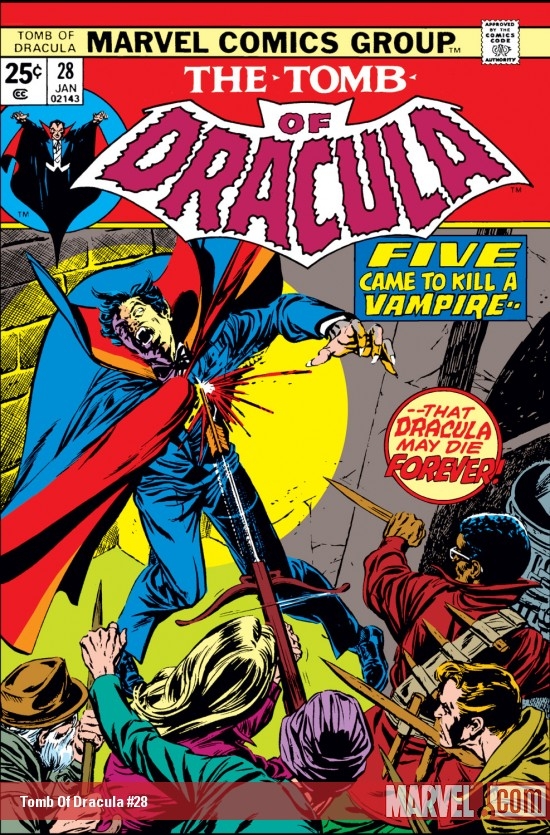
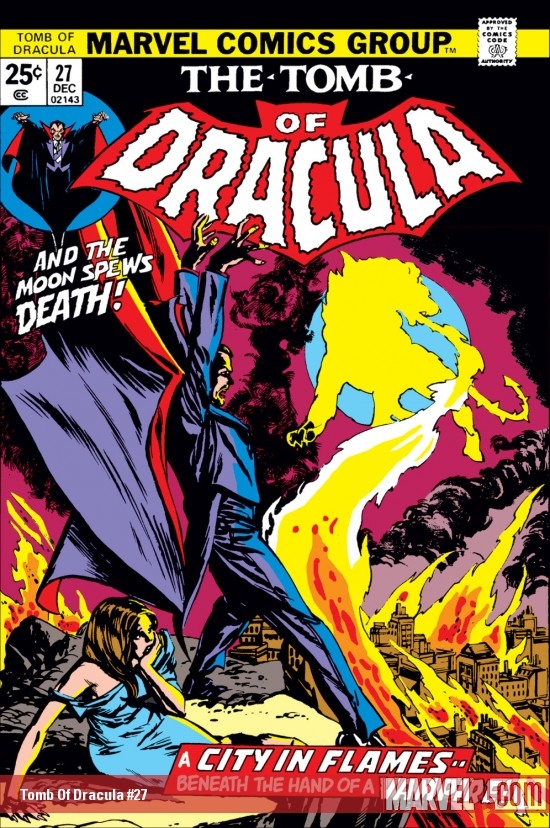 Issue #27, “Night-Fire” opens with Dracula failing in his painful escape attempt from his prison. Chastity and Frank arrive in Brazil and are met at the airport by Danny Summer. Danny surprises Frank with a job offer to head up his company in Brazil. Back in London, Rachel confides in Quincy her fears that Frank will not return to her. Dracula awakens and finds he is wandering on a London road with no idea of how he made his escape. Back at the secret London base, the unseen mastermind who has sought the Chimera disposes of a deceitful agent. David and Sheila come upon a disoriented Dracula on the road in the pouring rain. Dracula takes the tail-piece of the Chimera and conjures the mystical creature to cast fire from the sky both in front of them and against Taj Nital and Ramon thousands of miles away. Wielding the talisman once more, Dracula raises an undead army to life from Highgate Cemetery to ravage the surrounding homes. David fights Dracula, scalding him badly with the Star of David he wears about his neck. The two issues have dealt with self-doubt leading one astray. Frank chose to follow that path, while David chooses the path of his father and embraces his Jewish faith. The unexpected ending sees the mysterious Gnostic agents arrive and hold all three at gunpoint.
Issue #27, “Night-Fire” opens with Dracula failing in his painful escape attempt from his prison. Chastity and Frank arrive in Brazil and are met at the airport by Danny Summer. Danny surprises Frank with a job offer to head up his company in Brazil. Back in London, Rachel confides in Quincy her fears that Frank will not return to her. Dracula awakens and finds he is wandering on a London road with no idea of how he made his escape. Back at the secret London base, the unseen mastermind who has sought the Chimera disposes of a deceitful agent. David and Sheila come upon a disoriented Dracula on the road in the pouring rain. Dracula takes the tail-piece of the Chimera and conjures the mystical creature to cast fire from the sky both in front of them and against Taj Nital and Ramon thousands of miles away. Wielding the talisman once more, Dracula raises an undead army to life from Highgate Cemetery to ravage the surrounding homes. David fights Dracula, scalding him badly with the Star of David he wears about his neck. The two issues have dealt with self-doubt leading one astray. Frank chose to follow that path, while David chooses the path of his father and embraces his Jewish faith. The unexpected ending sees the mysterious Gnostic agents arrive and hold all three at gunpoint.
Issue #28, “Madness in the Mind” brings the storyline to an unexpected conclusion. The issue opens in India where Taj reunites with his wife and we learn the source of their pain – their adolescent son is a vampire and lies bound in his room with a crucifix on the wall and cloves of garlic covering him. The people of their village demand their son be burned at the stake for fear the vampire pestilence will spread. Meantime Dracula, Sheila, and David are brought before the secret base of the unseen mastermind. Their host uses the now completed Chimera statuette to torture all three of them by manipulating their minds so that they live through waking nightmares of their deepest fears. Dracula is eventually strong enough to resist and easily devastates the Chinese agents who staff the house and recovers the Chimera for himself. Unexpectedly, Sheila wrests the statuette from him and destroys it. Dracula is beside himself with rage while Sheila announces she is leaving Dracula for David. The issue ends with the two simply walking away from the vampire leaving him powerless to make her stay. While a very effective scene, readers know the vampire’s self-pity will only last so long before his pride demands that he claim his vengeance.
William Patrick Maynard was authorized to continue Sax Rohmer’s Fu Manchu thrillers beginning with The Terror of Fu Manchu (2009; Black Coat Press). A sequel, The Destiny of Fu Manchu is due for publication in December 2011. Also forthcoming is a collection of short stories featuring an original Edwardian detective, The Occult Case Book of Shankar Hardwicke and an original hardboiled detective novel, Lawhead. To see additional articles by William, visit his blog at SetiSays.blogspot.com
Some great comics here. I think the Wolfman/Colan/Palmer team really began finding their groove at about this point on the book. #24 is a fine issue, with, as you note, excellent characterisation not only of the lead but secondary characters; and not only in the writing, but the art. Colan and Palmer have their characters *act*. Their stances and expressions bring out who they are and what they’re feeling. But the writing’s strong, as well. The balancing of the relationships is excellent, and begins some long-running and well-executed plot threads.
For any other title, #24 would be memorable issue; for this one, it’s a nice installment, and I can’t help but feel it’s overshadowed by the #25, which to me is perfect start to finish. The narration’s vivid, the storytelling’s strong, and all the little clues are there to tip you off to the twist ending. Plus, details are unobtrusively seeded in extending long-running plot threads. Just excellent craftsmanship.
And, as I say, for me Hannibal King’s a great, great character. I know vampire PIs have been done since that issue (P.N. Elrod has a series that Wikipedia tells me started in 1990), but I don’t know of any that were around before. And Wolfman nails the idea, the attitude, the mixing of genres … it works. The detective searches for truth and justice; horror tells us that justice is uncertain at best, and the whole truth unknowable. Wolfman finds a way to balance these two approaches.
And, as a bonus, the letters column had probably the most thought-provoking letter I’ve ever read in a comic. A guy named L. Dale Seago who was a priest of the Church of Satan wrote in with a fascinating examination of Dracula’s character in light of Satanic beliefs. It was an intelligent, surprisingly objective examination of themes in the book, I thought, and given how the story developed in later issues, I wonder how much it affected Wolfman. Personally, I’d have to say I never expected to read the phrase “Thanks to Stan Lee for a truly Satanic publication” in a Marvel comic.
And then, after all that … the book kept getting better. The Chimera three-parter (and its epilogue) is so powerful. The Chimera itself is an interesting concept; it’s the kind of vastly powerful item you can see working in a high fantasy setting or a superhero setting (it’s basically the equivalent of the Cosmic Cube), but here it’s in a horror story, and it’s made to work as such. In fact, the reference to Kull and Valusia somehow heightens the horrific atmosphere, adding a sense of depth and inhuman stretches of time to the story. It’s a faintly cosmic touch that could have overwhelmed things, but under Wolfman’s guidance instead lends the whole story another level of power.
Wolfman returns to the religious themes of the Josiah Dawn story, but they’re subtler, more fully worked into the book. David’s faith in the God of his fathers is tested, and contrasted with Dracula’s belief in himself and comfort with evil. It’s fascinating stuff, and Wolfman shows some fine technical chops; the splash page of #27 has three long caption boxes, giving internal monologues of three different characters, setting each of them up as individuals but also establishing a dialogue of points-of-view that the story explores. Really well-done; as you say, there’s a level of sophistication here that I don’t find in contemporary mainstream books.
I think Wolfman understood and pulled off two things with this three-parter, and the book as a whole. One, he understood that for horror to be really affecting, you have to have characters you can believe in and relate to as humans. David and Sheila fit the bill perfectly. Two, he understood how to play Dracula; when he should be sympathetic, when he should be terrifying, when he should be sympathetic *because* he’s terrifying — and, above all, when he should be terrifying because he’s sympathetic. It’s a delicate thing to make work, and he turns the trick with real skill.
By contrast to all the above, the Giant-Size story is kinda fun, but definitely let down by Heck’s artwork. It’s a pity; Heck was always ill-suited to the superhero form, but he had some nice moments that suggested he could have made a good romance artist. Here, though, I think his attempt at horror work really fails. His design sense is generic, he never really seems to figure out how to draw Dracula, and the flashback to Atlantis is bland. Even the storytelling’s conservative. And what’s really aggravating … the pre-Silver Age reprint that follows the main story had art by Heck, and it’s much better, much more vivid and energetic.
Claremont’s script is fun, if a bit hammy, and it’s cute to see him sneak a mutant into a horror book (just as later he’d sneak Dracula into X-Men). But, again, I don’t think he grasped the complexities of Wolfman’s Dracula either. It’s a good mid-70s Marvel comic, but not to the level of what Wolfman was doing in the main title.
Again, great post, and looking forward to more!
Another brilliant post, Matthew. I’m starting to think you should be doing these articles instead of me! Well done as always.